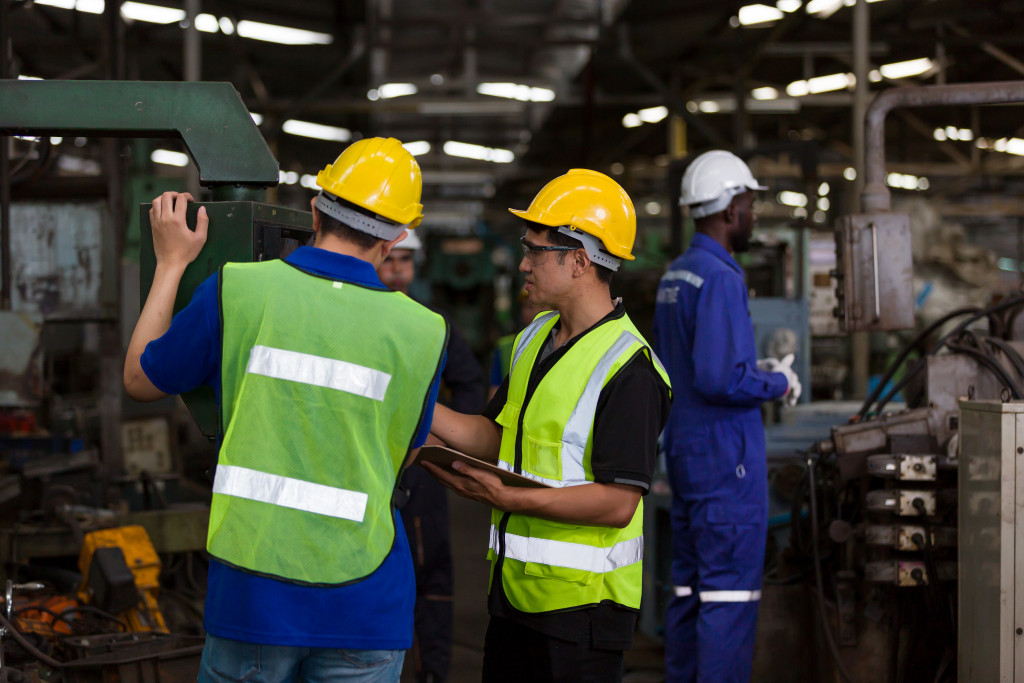- The spatial layout design of a manufacturing floor is critical for reducing slips, trips, and falls.
- Safety buffers can help reduce the severity of injuries in a manufacturing setting.
- Employee safety training is essential to ensure workers understand how to spot and react to hazardous situations.
- Proper ventilation must be maintained throughout the factory to help dissipate odors caused by hazardous materials used in various processes.
Manufacturing is essential to the modern economy, enabling countries to develop and grow their industrial output. Without it, goods and services would not be able to be produced quickly or efficiently enough for people’s needs. However, as with any work environment, safety precautions must be taken when working in a manufacturing setting. The working conditions can often be hazardous, and employees must ensure that they work in a safe environment.
Every year, millions of workers worldwide are injured while on the job due to accidents in manufacturing settings. In the US alone, there were 2.8 million nonfatal workplace injuries reported by private industry employers in 2019, with an average of 3.1 cases per 100 full-time workers – this is higher than the combined construction and agriculture industries!
In addition to physical injury, workers in these environments can also suffer long-term health effects due to prolonged exposure to chemicals or dust particles in many manufacturing processes. These include respiratory issues such as asthma, skin allergies due to contact with certain materials or chemicals, fatigue from extended hours of labor, hearing loss from loud machinery operations, and much more.
If you have a business that requires manufacturing, here are a few tips to help you regarding safety.
Spatial Awareness

The spatial layout design of the manufacturing floor and its pieces of equipment is essential for worker safety as it helps to reduce slips, trips, or falls as well as collisions between personnel or equipment. Keeping workers and machines at a safe distance from each other prevents accidents that can lead to severe injury or death. Properly organized layouts also help to maximize productivity by reducing waste in travel time, material handling, and employee fatigue.
Regarding specific layout considerations, all pathways must be marked along with the necessary, safe distances between people and machines. All handrails should be secure and constructed at a comfortable height suitable for people of different sizes. The placement of machinery should be such that employees can access them without having to walk around obstacles which increases safety hazards. Additionally, any stationary machinery must be properly anchored to prevent unexpected movements which could cause injury to workers. Where possible, push-pull devices should be employed rather than manual lifting to reduce strain on individuals’ bodies.
The lighting level within a manufacturing environment should also be considered when designing a floor plan. Poor illumination can result in inadequate visibility, which increases the likelihood of an accident occurring due to a person not being able to see an obstacle ahead of them or their surroundings enough. Adequate ventilation must also be provided throughout the worksite; this helps maintain air quality while dissipating odors caused by hazardous materials used in various processes, which can cause health problems if inhaled over long periods.
Safety Buffers
While spatial awareness can help prevent accidents, it is still vital to have safety buffers in place for those times when unexpected incidents occur. Most of the time, experts operating the machines can still react fast enough to prevent injury. Still, the presence of safety buffers can help reduce the severity of any potential damages.
Safety buffers are protective devices installed in machines or around hazardous areas to absorb or deflect energy created by sudden movements or collisions. Here are a few of those devices:
Safety mats
These are specially designed mats placed around machines and are used to detect when an employee comes into contact with the device. They will shut down the engine if they see pressure or impact, preventing injury.
Light curtains
Safety light curtain sensors create a barrier between personnel and machinery that is triggered if someone enters the area. The screen will then shut off the machine to prevent injury from occurring.
Pressure-sensitive edges
Pressure-sensitive edges are installed on some machinery to sense when something comes into contact with them and shut off the equipment before any potential harm can occur.
Emergency stop devices
An emergency stop button should be accessible at all times so employees can stop the machinery quickly and safely. Most manufacturing machines have this button installed, but it is vital to check that all devices have one.
Employee Safety Training

No matter how trained you are at operating a machine, it is impossible to anticipate every potential hazard. That is why employee safety training is essential for any manufacturing environment. By providing all employees with safety instructions, you can ensure that everyone working in the factory knows how to spot and react to potentially hazardous situations, which could prevent injury or even save lives.
Employees should be trained on the proper use of machines, safe operating procedures, and any relevant laws or regulations regarding health and safety. They must also understand the potential hazards associated with each task they are expected to carry out and how to identify warning signs that might indicate an unsafe situation or machine malfunction. Regular refresher courses should also be held, so workers remain up-to-date on safety protocols.
Final Thoughts
Safety is essential in any manufacturing environment, and taking the necessary precautions can help to reduce the likelihood of injury or death. By understanding the importance of spatial awareness, implementing safety buffers, and providing adequate training to all personnel, you can ensure that your factory floor remains safe.

